Buddhism in Star Wars
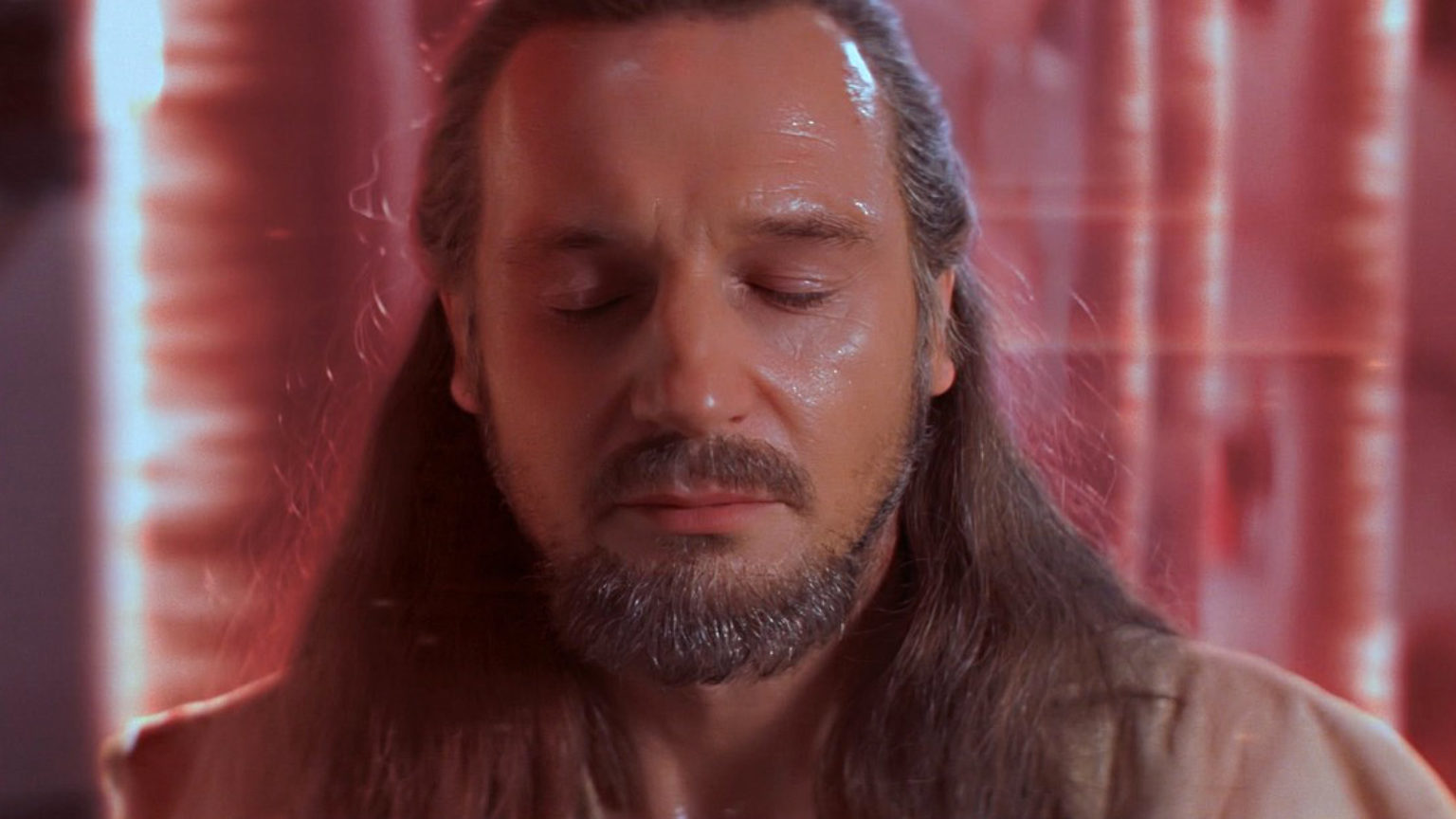
Approaching his last moments, Qui-Gon Jinn (Liam Neeson) does not dwell on the anxiety of fighting Darth Maul. Nor does he simply wait for the laser gate to open. He opens himself up to the Force, mindfully drawing himself to its will. (20th Century Fox)
Without doubt, Star Wars is one of the most-accomplished film franchises of all time. Nine movies form the ‘Skywalker saga’, which were all nominated for Academy Awards, signifying critical acclaim as well as financial success; and there are movie spin-offs, books, fanfiction, and games. Labelled an ‘epic space opera’, Star Wars is a pop-culture phenome—
Look, I’m not going to describe what you can find on Wikipedia by yourself. You get the point. You are alive and, as such, you know that Star Wars is kind of a huge deal—still. This has been the case since A New Hope came out in 1977.
I grew up with my brother’s Star Wars toys and have memories of watching the first trilogy. Star Wars then became an especially huge deal to me, a child of the 1990s and 2000s, when ‘the prequels’ came out. I was so young when The Phantom Menace came out in 1999 that I actually liked Jar Jar Binks and I genuinely enjoyed the overindulgent podracing scenes (which I replicated in loops on Tatooine on my Nintendo 64). By the time the final three films of the Skywalker Saga were released I was a sufficiently wise and nostalgic 20-something-year-old who was ready to immerse themselves in the Star Wars universe once more.
But this article isn’t about how popular Star Wars is or my memories of it: this article is about Buddhism. As a mature [cough] adult, I have come to appreciate the spirituality of the Jedi from a different angle. While I have always been tempted to put Jedi as my religion on the census, I’m not a spiritual person. However, I can appreciate other philosophies and I find it exceptional that in Star Wars—a Western, commercially successfully, sci-fi franchise made for nerds—an Eastern religion is heavily situated.
What pushed me towards thinking about this crossover of cultures in more detail is a book I read recently called The Dharma of Star Wars. I’m not going to lie or mince my words: the book is poor in terms of philosophical insight. It lacked analytic depth and wildly spiralled around speculative assertions, failing to connect the dots in significant ways and succeeding at sounding very ‘wishy-washy’. That being said, the book is well-written and accessible and I was inspired by specific connections the author, Matthew Bortolin, made between the Jedi way and the religion of Buddhism. I came away finding my own connections between the Star Wars spirituality and the teachings of the Buddha. I therefore owe this article to him!
I won’t give a comprehensive philosophical analysis either—yes, I know: I’m a hypocrite—but I will run through some of these connections. When you watch the film next time you can draw your own connections.
Let’s go.
Mindfulness
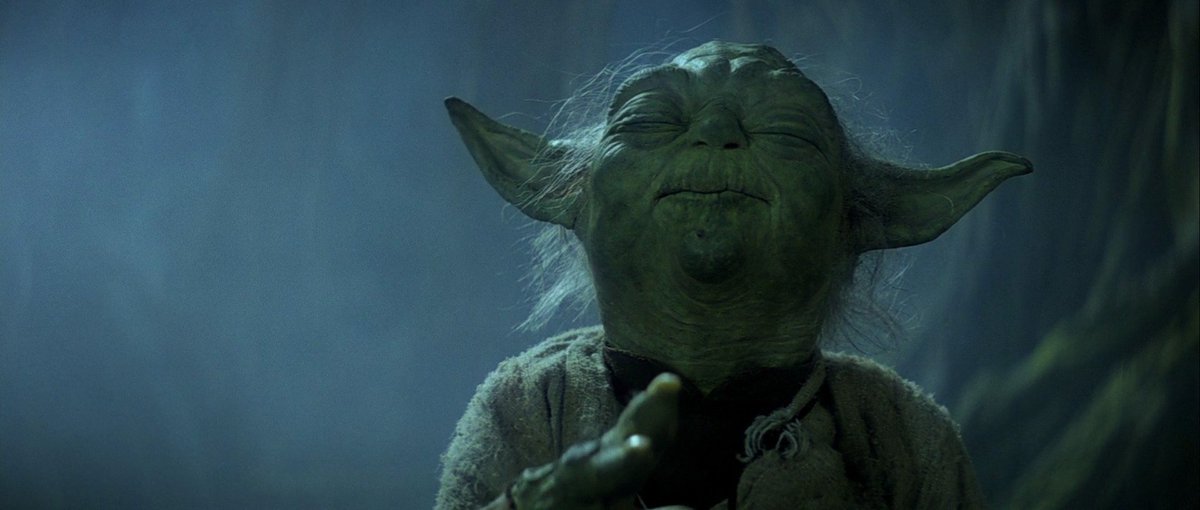
Yoda mindfully engages the Force to lift Luke’s X-wing starfighter out of a swamp in 1980’s The Empire Strikes Back. (20th Century Fox)
The Jedi Order are peacekeepers. They work with Galactic Republic and the Rebel Alliance to maintain peace and justice across the galaxy, protecting all life in defence and never in attack.
Whereas the Jedi are devoted to the ‘light side’ of the Force, the Sith Order, who emerged from a schism of the Jedi Order, are devoted to the ‘dark side’ of the Force. (Although real life is not so simple, people speak as if there is a similar division between good and bad on Earth, too.)
Much distinguishes the values of the Jedi and Sith orders, who are at war throughout Star Wars (read the Jedi Code to learn what the Jedi believe in exactly). However, there is something they share significantly which was inspired by Buddhism: namely, the application of mental techniques.
Both the Jedi and the Sith are able to wield the power of the Force, harnessing its energy in their surroundings. Using tools such as meditation (dhyāna) they can wipe away sense-impressions and control their environments through a state of mindfulness (sati), enhancing their sense faculties beyond what is directly present in perception. (Powerful Jedi can read minds, see into the future, move objects via telekinesis, and more.)
While the means to the ends are essentially the same between the two orders, the ends themselves are not: through mindfulness the Jedi seek to bind their fates to the will of the Force, unselfishly being guided by a higher power; the Sith, in contrast, concentrate on their own wills, maximising individualistic power.
To be mindful is to be acutely aware of the present. It is a state of mind of which meditation is just one practice. People use mindfulness in the real world to improve their wellbeing. By removing society’s noise and focusing on their own thoughts, they rid themselves of the irritations that plague their inner peace and become stronger as a result.
In Buddhist philosophy mindfulness is seen as a path to ‘cleansing the mind of all discriminations and conceptions, leading to a preconceptual stage of perception’. This sounds familiar from a Jedi perspective: the Jedi gain insights into their deepest mental spaces by applying mindfulness, which gives them access to the Force. Distractions are batted away as they connect to the Force, giving the Jedi special abilities and thus significant advantages over Force-less assailants. From the films we can deduce meditative techniques are likely common across the Jedi Order. For example, some practices bear striking similarities to certain yoga poses (Yoda clearly loves a bit of yoga) and the Jedi practise breathing-control exercises (Luke does so on Dagobah).
The influences are literal, too. Director George Lucas apparently took inspiration from Samurai warriors to coin ‘Jedi’, whose etymology comes from ‘jidai’ (Japanese). ‘Jidai’ is short for ‘jidaigeki’, a movie genre heavily featuring Samaria warriors. Many of the Jedi’s names even sound Oriental or otherwise East Asian (e.g., Yoda and Obi-Wan Kenobi).
But the similarities run deeper. Samurai warriors were highly spiritual people who, at least in the depictions of jidaigeki movies, were inspired by their moral values, which can be compared to the Jedi way. Samurai warriors were taught how to calm their minds following Zen teachings such that they could increase their focus in the present, for example, during sword fighting—something we can recognise in a meditating Qui-Gon Jinn just before he fights Darth Maul in that lightsaber duel [‘Duel of the Fates’ plays]. Both Zen and Jedi teachings also impress on the importance of compassion—selflessly benefitting others; unconditional love—and imposing self-restraint and frugality.
The resemblances are undeniable.
Interdependence
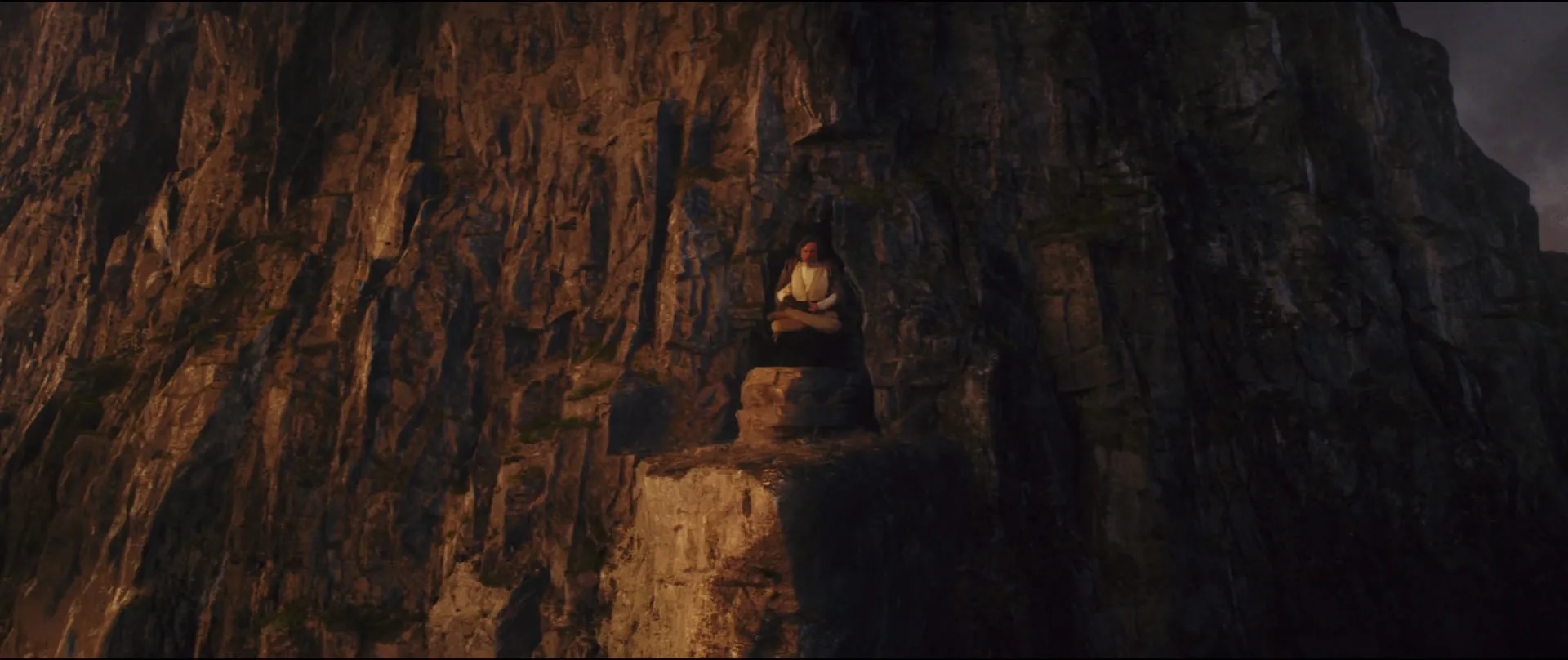
In this scene from 2017’s The Last Jedi Luke (Mark Hamill) sits cross-legged, tranquil in a deep state meditation, levitating, at one with the true nature of reality—a rather overt nod to Buddhism: Luke is reminiscent of Siddhārtha Gautama, Lord Buddha. (Walt Disney Studios Motion Pictures)
Individuals in mindful mental states are able to cultivate greater understandings of reality—or so Buddhists and the Jedi believe. A key feature of reality that many of us miss in our superficial attachments to sensory experience and cognition is reality’s interdependence, for things are connected in ways which are not immediately obvious to us.
Pratītyasamutpāda is a Buddhist doctrine which states that all being is connected. If one entity disappears from existence, so do others: they coexist. Such is the principle of dependent origination. Pratītyasamutpāda, then, kind of works like causation (a more-familiar idea in Western philosophy) except, in this case, interdependence must be imagined as a great web of dependence of entities (sankhata) as opposed to mere chains of events. These entities, dharmas, incorporate many doctrines through which law and order is governed in the Universe.
Analogously, the Jedi believe that everything is connected through the Force, which stores greater power than any Jedi can offer individually or as a sum. Nevertheless, the Jedi—highly trained in the art of mindfulness—can illuminate their minds to feel these connections, regardless of certain physical dispositions …
But, we might ask, how is everything connected? Specifically, how do the Jedi’s mental powers have physical effects? The Jedi are ‘luminous beings’ who possess exceptional mental faculties. They have the ability to manipulate the Force to physically move objects with their minds. Arguably, then, there is a mental connection between (1) Jedi, (2) the Force, and (3) the material objects the Jedi move. Therefore, the Force and material objects carry properties of consciousness such that there is a tripartite connection is maintained between all three.
This puts Yoda and co into the panpsychists’ camp. Panpsychism is the thesis that everything in the Universe has properties of consciousness, even subatomic particles; the extent to which something is conscious just depends on the arrangement and sophistication of the matter involved. However, maybe Yoda would be forced to admit that the Jedi are really just sophisticated arrangements of ‘crude matter’, too, and I really don’t want to be the one to tell him that.
Either way, the Force gives the Jedi access to something bigger. The Force makes them more powerful but it also beneficially links all that is with it. In the The Phantom Menace Obi-Wan hints at a ‘symbiont cycle’ through which individuals and the worlds they occupy emerge with a stronger sense of unity.
This unity exists both in A Galaxy Far, Far Away and in the Buddhist conception of the universe: something macrocosmic and bigger than the sum of individuals; something to which individuals should be tied without care for self (if there is one); a bigger order whose fate is the only one that matters, whose will we ought to seek harmony with, whose identification with releases one from the shackles of birth and death.
Perhaps what this ‘bigger order’ is exactly is best left unexplored as a concept in Star Wars; else we might annoy ourselves by attempting to explain Leia’s flying through space in The Last Jedi.
Alas, in the prequels midi-chlorians are offered as the foundations of a quasi-scientific explanation for scientifically minded audiences. These are intelligent, microscopic life-forms which reside inside the cells of all living things. The number of midi-chlorians in an individual can be measured with a blood test. The higher the count the more Force-sensitive the individual is, giving the host intimate knowledge of the Force. I take this explanation to be divisive amongst the Star Wars community. So maybe the creators should have maintained an unexplained yet intriguing mysticism to match Buddhism. But at least they tried.
Suffering
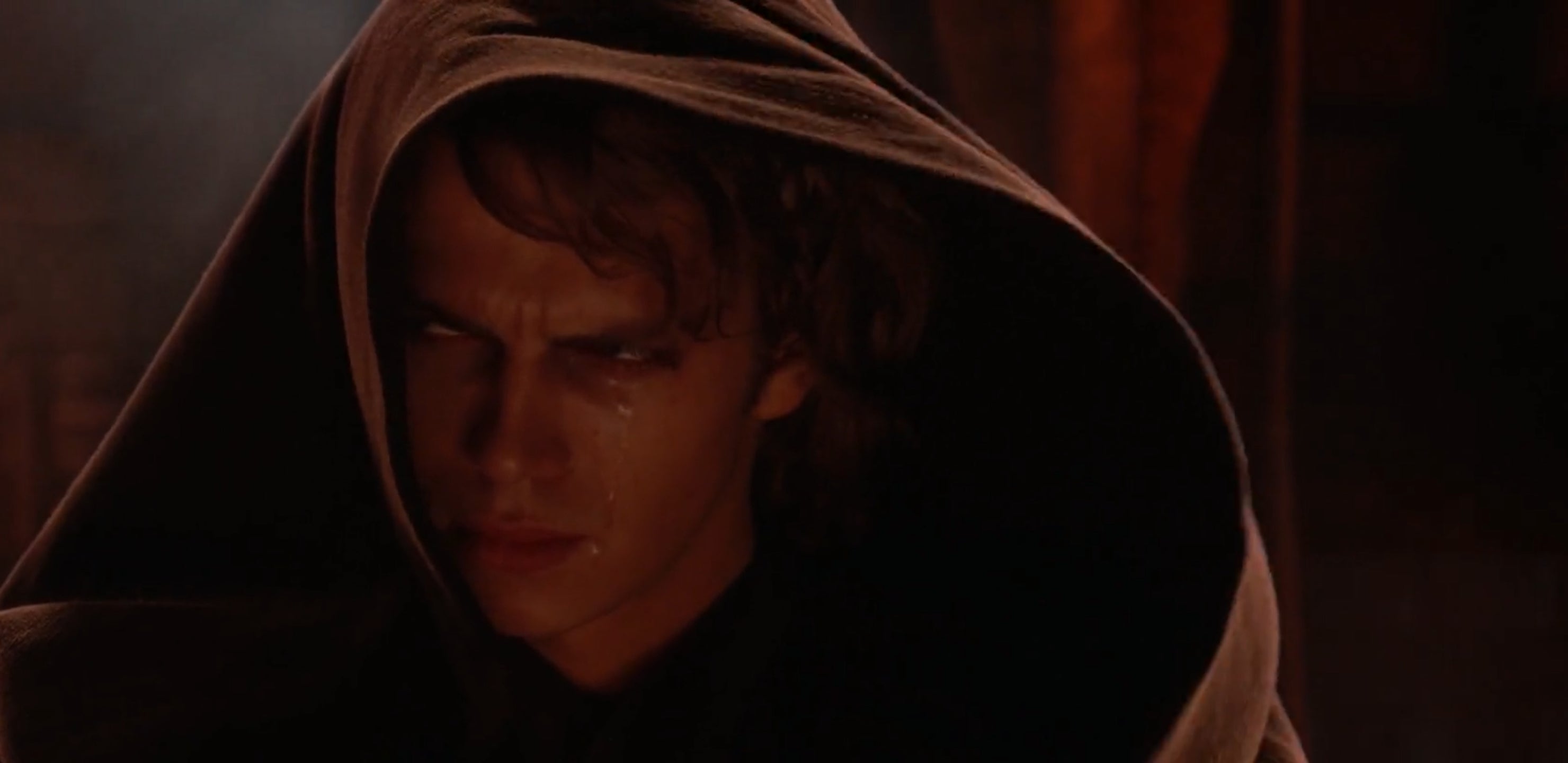
The Star Wars prequels tell the story of a bright boy, Anakin Skywalker (Hayden Christensen), whose passage into a villain, the nefarious Darth Vader, can be explained via his suffering. Darth Vader uses personal power for his own ends, one of the first instances of which is to save his wife. He fails. The Jedi Code forbids such activity. Like Buddhists, the Jedi preach of acceptance. (20th Century Fox)
An essential element of Jedi teaching is the philosophy of non-attachment. If one becomes attached to something, they fear losing it. In this state of mind an individual becomes imbalanced, which can lead to destructive outcomes, as they attempt to rebalance the Force in favour of their attachments.
This is not the Jedi way. The Jedi way is to accept pain as a central to life. To quote the Grand Master:
During our short lives we become old and sick. The things we hold dear change beyond recognition in that time; what is familiar is continually upturned. We lose family and friends and other people we love along the way. To others, we cause pain simply by being born. Their pain, even when it is unrelated to us, has a way of hurting us. We eventually die.
The ‘dark side’ constantly tempts us into fixing things out of this order. It sits within each of us. It urges us to denature the world to yield what justice we deem to be missing from the natural order of things. According to the Jedi, pain is inevitable wherever we go. By making its eradication a target of our minds we actually make it an object: we beget suffering by trying so hard to be rid of it; we frustrate ourselves; we attach ourselves to suffering.
The best solution, then, is one of acceptance: of detachment from the desire to ‘fix’ things. Our immediate desires always tempt us in this way. But we should look beyond our own senses of microcosmic justice and seek to macrocosmic justice—to the greater will of the Force.
We see this theme arise time and time again in Star Wars, particularly during the Skywalker Saga, in which multiple characters experience suffering yet must find new paths of clear-headed virtue—the Buddhist way.
Anakin Skywalker, a talented and caring Jedi, fears losing Padmé. So he turns to the dark side to prevent her death, which he sees in visions. But, by using his power for individualistic reasons, he ends up suffering more, laying the blame at the door of the Jedi Order when his attempts don’t work. He thus transforms into Darth Vader: the poster-boy for the dark side; the embodiment of giving into desire. Anakin didn’t not care about people: he cared too much. He simply allowed personal strife to dominate his wider perception.
In the subsequent generation of Skywalkers it is Luke, Anakin’s son, who feels the temptation of the same path. He wants to kill Vader, his own father and the source of the galaxy’s suffering. But in doing so Luke becomes Vader (seeing his face in Vader’s helmet in an illusion on Dagobah).
Similarly, Rey and Kylo Ren, in anger and revenge, follow Anakin and Luke as they seek to overthrow evil powers. Though they do not seek power for power’s sake, their journeys are initially motivated by false promises that they will bring peace to their wrecked souls by killing malevolent people. This will never bring one tranquillity to their inner being.
All of these character’s motivations are motivations to which we can probably relate. We want to restore what is good and banish what is not, perhaps through forcible means. However, the Jedi warn that appeals to punishment and retribution entrap one into a dark side of thinking which ought to be quenched. Peace is only found in a full awakening: in compassion and the relinquishing of selfish and transient desires. It is not easy but that is how peace is attained in the world. And Buddhism leads the way …
Learning to let go
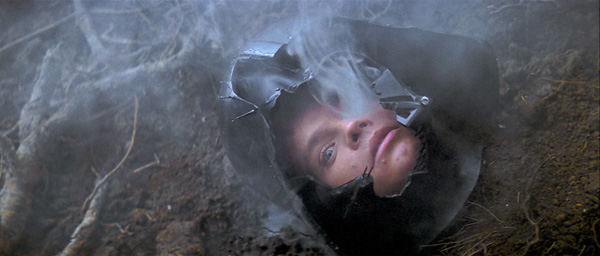
In The Empire Strikes Back Luke fails his initial training with Yoda on swamp-planet Dagobah. Luke had to overcome his urge to obey the desire to kill Vader. This is no trivial task. The dark side is always alluring—not just in A Galaxy Far, Far Away but here on Earth as well. (20th Century Fox)
Accept what is: this is the moral of the 9-part Skywalker Saga story. For learning to let go is the only route towards the cessation of suffering in one’s life. It is also one of the Buddha’s main teachings. But how do we do it? Let’s use Luke life as a case study.
Darth Vader is a source of evil in the galaxy. However, Luke becomes too fixated on killing him, which becomes his suffering, seeing himself in Vader’s helmet in a vision.
To avoid this path and eliminate suffering in his own life—and find enlightenment—Luke has to overcome his desire to kill Vader and find greater answers, that is, resist what feels right immediately and transcendentally adhere to the will of the Force. The Force wills for something greater: for Luke to stop identifying with suffering. Duly, Luke’s choice is to save, not kill, Vader. Only then is Luke strong enough to bring about the return of the Jedi Order.
The Jedi look to the higher power of the will of the Force for answers. Similarly, Buddhists instruct us to be understanding and unconditionally compassionate towards other beings. But some of these messages are challenging to hold close. We might, for example, question why the wickedest of people deserve unconditional love and sympathy from us: they chose their evil paths freely.
Buddhists—and, indeed, the Jedi—believe these worries to be short-sighted and there are some compelling reasons to follow them. The solution, they say, is not to strive for perfection in one’s own life but to learn how they are and accept things as they are. Practically, then, we will come to see how people become bad, feel sorry for them, and hope they join an enlightened path with them.
The Buddha, Siddhartha, reveals various truths in the Dharma, most of which draw lessons from his observations of people unnecessarily suffering out of their own ignorance.
People are ignorant of reality’s true metaphysical nature (avidyā). They follow unfettered sensory experience. They cling onto things that will inevitably change. They embark on futile searches for personal meaning. They suffer from their craving (as per the concept of tanhā). They must let go. Though people struggle to let go of these things emotionally, they can win the mental battle. Seeing a bigger picture reveals deeper connections.
The idea of letting go has long roots in various strains of Buddhism. The Buddha crucially set out that suffering is a product of the mind; it is created externally. We feel pain, of course, but by examining it, mindfully inspecting its origins and learning of harmonious interdependence, we will come to appreciate reality in new lights. We will see how we too often misplace trust in human desire, which so frequently is the cause of suffering (e.g., through greed and anger). It triggers us to blame others and exact petty revenge, the ends of which are rarely fulfilling.
We might, however, feel that, compared to blanket acceptance, it makes more sense to be aggrieved by various injustices—for example, by the many horrific illnesses and diseases we are stricken with, criminality, selfishness, corruption, and more: how do we accept those? This is a challenging question.
Reality is always in a state of flux. However, in this there is beauty. The wabi-sabi worldview, for instance, imparts the wisdom of appreciating imperfection, impermanence, and incompleteness in things. We should engage life as it is: rough, asymmetric, and empty. ‘Nothing lasts, nothing is finished, and nothing is perfect’ (Richard Powell).
According to the Buddha, ignorance is eliminable: knowledge is possible.
Suffering is lifted into existence by human desire: desire can be extinguished and take suffering with it (gifting one ‘liberation’, by Schopenhauer’s lights, contra Nietzsche).
These realisations lead one down the Buddhist path of enlightenment: towards eradicating that pointless emotion which clouds the mind; within reach of serenity, compassion, harmony, and higher happiness; to being in a transcendental state of nirvāna—viz, at one with the Force. And may it be with you, always.
